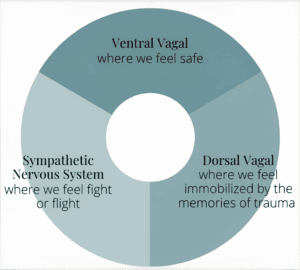The Hidden Language of Your Nervous System
This article has been researched and written by Moni El Ramlawy. AI has not been used in producing this article.
Before you say, “I’m fine,” your nervous system has already responded. That response doesn’t come from logic, reasoning, or even conscious thought – it comes from your body’s survival system. Polyvagal Theory, developed by Dr. Stephen Porges, offers a powerful lens to understand how our nervous systems respond to our emotional triggers. It tells us that we’re not just reacting to the world through our thoughts – we’re constantly scanning for cues of safety and danger. According to this theory, our nervous system navigates three main states to manage stress. When we understand them, we begin to decode the hidden language our body speaks every day.

1. Safety & Connection (Ventral Vagal State)
This is your state of presence and regulation. When you’re in ventral vagal, your body feels safe and calm. This is your “I’m okay, I’m connected, I can think clearly” state. In this state, you can experience joy, healing, intimacy, and connection. You can express emotions, problem-solve, and reflect.
2. Alert (Sympathetic State)
This is a state of threat, and when your nervous system detects threat (real or perceived), it shifts into action. This is what we call the fight-or-flight response. You might feel agitated or anxious. Your heart races, muscles tense, and everything feels urgent. This is not a weakness; it’s your body trying to protect you, and while this state is essential for survival, being stuck there for too long can lead to burnout or chronic stress.
3. Shutdown (Dorsal Vagal State)
This state is like an emergency brake. When the threat feels overwhelming and escape seems impossible, the body goes into a state of freeze. You may feel spacey, numb, or exhausted. It can look like depression, but it’s actually a survival response when fight-or-flight no longer works.
Learning to notice these states helps you recognize your emotions. When you begin to understand how your nervous system works, you gain the power to regulate – through breath, movement, connection, and support – and you become more attuned to what you need: a pause, a boundary, a hug.
When Anger Visits: A Parent’s Guide to Calming Big Emotions
Anger is a natural and necessary emotion—but for children, it can feel overwhelming and hard to express.
Breathing Techniques
Breathing has always played a central role in body-centered healing techniques …
Validation: How To Do That ?
This article will discuss what validation means, what it does not mean, and how to effectively use …
The Hidden Language of Your Nervous System
Before you say, “I’m fine,” your nervous system has already responded. That response doesn’t …
From the Ahi Brotherhood to Attachment Based Mentoring: A Legacy of Belonging
In today’s fast-paced world, where modern life pressures parents to maximize productivity …
Understanding Autism: A User Friendly Perspective
Autism is often described as a “spectrum,” which can be somewhat misleading as it can seem …
Panic, Stress, and Anxiety Facing the Giant Praying Mantis
We often throw around words like panic, stress, and anxiety as if they were the same. They’re not …
Why That Chewing Noise Drives You Crazy
It’s called misophonia, which literally means “hatred of sound”! It happens when someone experiences …
Are Freudian Slips Accidents or Unconscious Desires?
Suddenly, there is silence, eyebrows are raised, and you’re left mumbling, while attempting to explain …
Effectiveness of Authoritative Parenting in Fostering Autonomy
Initially, a newborn relies completely on their parent, but over time, they transition from being an object …











